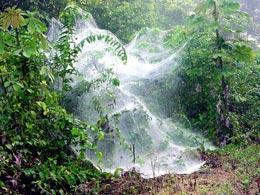
|
| ©Alexandre Bernard |
| An Anelosimus eximius communal web. |
Giant webs catch most food when occupied by about 500 social spiders.
For many people it's the ultimate nightmare: thousands of spiders collaborating to form a well organized society. A new study published this week in Proceedings of the National Academy of Sciences reveals how colonies of one spider species grow to an enormous size, and the surprising factors that ultimately limit their expansion.
Spiders are usually thought of as lone hunters. However, a few dozen species do live cooperatively, building collective webs and sharing food-gathering and child care between them. One example is the neotropical species Anelosimus eximius, which can be found living in colonies containing thousands of individuals.
Researchers based in the University of Arizona, Tucson, and University of British Columbia, Vancouver, have now examined colonies of the spiders in the Jatun Sacha Biological Reserve and Cuyabeno Nature Reserve in Ecuador, measuring the sizes of colonies and recording the prey captured in their communal webs.
Size matters
The team discovered that as colonies grew larger, they actually caught fewer prey per spider than smaller colonies. To explain this, they turned to allometry, the study of the relationship between size and shape in biology. This is usually applied to single organisms, but the researchers found that it was equally relevant for the whole colony of spiders.
As the number of occupants grows, the volume of the webs they construct increases - but the surface-area-to-volume ratio declines. The area of web is the all-important determinant of numbers of prey caught, so bigger colonies catch proportionally fewer prey items.
At first, researcher Leticia Avilés was puzzled by the finding: "It begged the question of why the spiders lived in groups in the first place."
But she and her colleagues found a factor that compensated for the numbers effect. When they estimated the biomass - the dry weight - of prey caught, they found that larger webs spun by bigger colonies are able to capture larger prey items. Larger portion sizes compensated for the falling number of prey - at least, up to a certain point.
Supersize me
Combining both of these factors, they found that the amount of food available for each spider peaked in colonies containing around 500 spiders. "Previous work had shown that social spiders are able to capture prey several times their body size. No previous work, however, had shown the relationship between colony size and the number and size of insects captured or between colony size and biomass captured per capita," notes Avilés.
It was previously known that above a certain size the colonies break up, with the occupants dispersing to form new colonies. This research now seems to provide an explanation. Although the study found many colonies larger than the optimum size, none was found with more than 9,000 spiders. Below this size the occupants are better off staying put than starting a new, much smaller colony.
"This is an exciting new perspective for thinking about how social web-spinning spiders have evolved," says Todd Blackledge at the University of Akron, Ohio, who studies web-weaving spiders. "In the past the focus has been on the genetic effects of inbreeding in colonies. This tells us a lot more about the ecological factors governing colony size."



Reader Comments
to our Newsletter